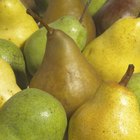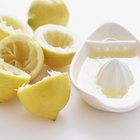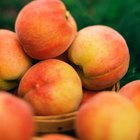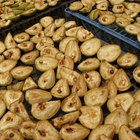kobeza/iStock/GettyImages
Few fruits are as lusciously juicy as a fresh peach, and the notion of preserving some of that sweet, summery goodness for a midwinter treat is almost irresistible. It's an easy project, but novices often find to their dismay that the peaches quickly develop an unappealing brown color when they're cut. This is caused by an enzyme in the fresh peaches, and it's easy to counter if you're prepared for it.
A Brown Funk
Peaches are appealing to a wide range of birds, bugs and animals, as well as to humans. They can't run away, so they rely on a chemical defense to provide some degree of protection. When they're cut, peeled or bitten, enzymes in the damaged cells are released to react with compounds in the peach and oxygen in the air. This chemical soup quickly produces a dark brown layer of oxidized fruit, which attacks and dissolves proteins. In fact, similar proteins from papayas are often used to tenderize meats. It's irritating and often dangerous to insect larvae, and delicate membranes in larger pests.
Preparing Your Peaches
The first step in preparing peach preserves is peeling and cutting up the peaches. Some patient cooks can peel them with a paring knife or vegetable peeler, but it's usually simplest to plunge them into boiling water for 30 to 60 seconds and then transfer them to a bowl of ice water. This loosens the skins, so you can pull them off easily with your fingers. Then cut the peaches in half, and remove the pit. If you wish, you can slice them further into wedges. At this stage, you'll need to act quickly to prevent browning.
Lemons To the Rescue
Like other chemical reactions the browning effect in fresh fruit can be inhibited by creating an unfavorable set of conditions. Acidity slows browning sharply, and immersing the peaches in water helps by reducing the availability of oxygen to trigger the chemical reaction. This is why most cooks drop their cut peaches into a bowl filled with cold water and lemon juice, usually 1/4 cup of lemon juice for every quart of water. The combination of cold water and acidity keeps the peaches fresh-looking while you pack and can them.
Alternative Solutions
Any food-quality acidic ingredient will help curb browning, though some -- such as vinegar -- are too strongly flavored to be practical choices. If you don't have lemon juice on hand, soak your cut peaches instead in orange juice. It's acidic enough to prevent browning, and the flavor will be unobtrusive in the finished preserves. Alternatively, use the anti-browning crystals sold in the produce section of your supermarket. Brands vary in concentration and package size, so follow the manufacturer's mixing instructions. If all else fails, the vitamin C tablets in your cupboard make an excellent alternative. Grind and dissolve three 500-milligram tablets in a half-gallon of water, and soak your peaches in that solution to prevent browning.
Related Articles

What Happens to Bananas Dipped in Lemon ...

Does Baking Soda Prevent Apples from ...

Does a Kiwi Turn Brown?

Why Pears Turn Brown When Pureed

How to Keep Peeled Vegetables From ...
Does Baking Soda Prevent Apples from ...
How to Wash Fresh Fruit With Peroxide

How Do I Prepare Pears for Freezing?
How Long Is it Safe to Keep Frozen ...
Why Does Lemon Juice Keep Potatoes From ...

Why Does Lemon Juice Stop Apples From ...

How to Freeze Peaches With a Vacuum ...
How to Keep Granny Smith Apples From ...

Best Fruit Juices to Cleanse the Colon

Is an Orange Healthy to Eat for Your ...
How to Freeze Papaya

How Can I Preserve Peaches Without ...
Can You Peel Potatoes the Day Before ...

How to Dehydrate Pears

Nutritional Value of a D'Anjou Pear
References
- On Food and Cooking: The Science and Lore of the Kitchen; Harold McGee
- National Center for Home Food Preservation: Selecting, Preparing and Canning Fruit -- Peaches, Halved or Sliced
- National Center for Home Food Preservation: Maintaining Color and Flavor in Canned Food
Resources
Writer Bio
Fred Decker is a trained chef and prolific freelance writer. In previous careers, he sold insurance and mutual funds, and was a longtime retailer. He was educated at Memorial University of Newfoundland and the Northern Alberta Institute of Technology. His articles have appeared on numerous home and garden sites including GoneOutdoors, TheNest and eHow.